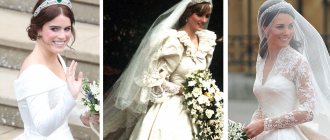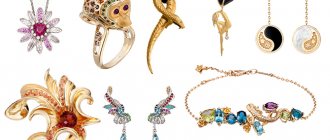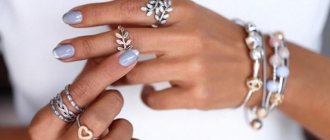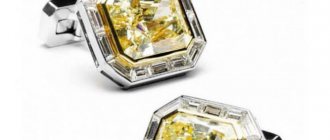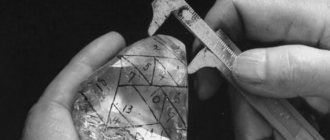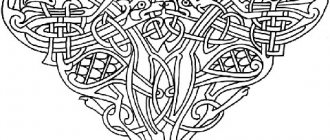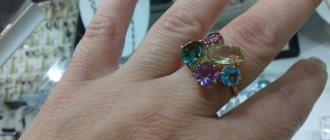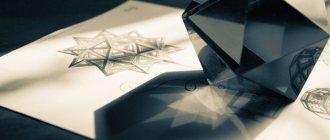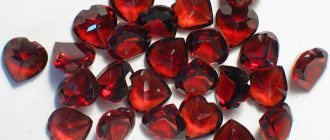Who creates jewelry for the royal family
Take a 10, 20 or 50 pound note from your wallet.
Take a close look at Her Majesty's tiara and you'll see part of the history of the House of Garrard, one of Britain's most celebrated jewelery houses. This stunning crown, called the Girls of Great Britain and Ireland, was presented to Queen Mary, wife of George V, as a wedding gift in 1893. In 1947, Mary gave it to her granddaughter, the current queen. The diamonds from this tiara were the source of inspiration for two Garrard collections - Twenty Four and Albemarle, named after the jewelery house's permanent address: 24 Albemarle Street, Mayfair.
For nearly three centuries, the House of Garrard has created the most sought-after jewelry in the world, and enthusiastic buyers of ready-made and bespoke jewelry become owners of timeless beauty.
The House of Garrard began its association with the royal house 283 years ago, when Prince Frederick of Wales became its patron. From the 1735 collection, the brooch with sapphires and diamonds that Prince Albert gave to Queen Victoria is still particularly beloved, as is Diana Spencer’s engagement ring, which is today worn by Prince William’s wife Catherine, the Duchess of Cambridge.
Garrard's unparalleled craftsmanship is recognized throughout the world, and the designers of this jewelry house with an unparalleled heritage appreciate the nuances of female taste like no other. The best traditions, romance, motifs from the past and a fresh look aimed at the future - this is the approach of the female creative team of the House of Garrard.
Claire Scott, Chief Design Officer, and Sarah Prentice, Creative Director, House of Garrard, pride themselves on their mutual support and strong working relationship. They are convinced that it is the female perspective that helps their business flourish. “Our main goal is to make exclusive Garrard jewelry suitable in every way. As women, we understand very well how to wear jewelry and still feel most comfortable.”
A new collection appears approximately once a year. Its development requires at least three months. Every day for the Garrard House team begins with pencil and paper. After creating a series of sketches, Scott and Prentice head to a palace or museum for inspiration to continue brainstorming while admiring the architecture and art.
“We explore ideas with our clients. Gradually, through conversations and discussions, an idea for a new collection is born. After that, we work through its concept and structure in the smallest detail, draw out all possible options and gradually come to a joint understanding of the image of the collection.”
Line drawings are then created using Adobe Illustrator. They are painted by hand and acquire a finished look, after which the client can express additional wishes and suggestions before the model is handed over for production.
What makes Scott and Prentice's work unique is their extensive previous experience in jewelry design and manufacturing. “Understanding the peculiarities of product manufacturing techniques helps us develop designs in such a way that the finished product closely matches the original sketches. It is extremely important to us to be sensitive to design and work closely with the craftsmen and the entire production team. This brings special job satisfaction.”
The House of Garrard has been producing fine jewelery for over 280 years and is a proud holder of an honorary Royal Order for excellence in jewelery craftsmanship, which is reflected in each piece.
To find out more, discover the unique royal heritage and explore the history of some of the jewellery's most unrivaled masterpieces, visit https://www.garrard.com and visit the House of Garrard at 24 Albemarle Street, London, W1S 4HT, UK.
Fit for a Queen: Court Jewelers of the English Court
The court history of the Garrard jewelry house began when Prince Albert stopped by the boutique in 1843 to order a brooch for his beloved wife, Queen Victoria. The young queen was not just a fashionista, but a trendsetter, and her jewelry was pioneeringly bold. Victoria was partial to large precious stones - Prince Albert personally ordered the cutting of an ancient Indian Kohinoor diamond and set it in the royal tiara - she loved spectacular brooches with images of flowers and insects - a tribute to the fashion of the Rococo era - and her husband ordered them from Garrard.
In the Garrard boutique, among engravings and photographs of the coronation regalia of British monarchs (Garrard, as the oldest jewelery house in Britain, existing since 1735, has had a hand in not a single royal tiara, tiara and scepter), surrounded by jewels, at an antique oval table, we begin our big jewelry tea party. Sarah Prentice, Garrard's creative director, pours tea from a large white teapot. To the left of Sarah is a shelf bowl with cakes and scones, right in front of her is a plate of sandwiches, and to the right is a scattering of diamond jewelry. Sarah Prentice is accompanied by Garrard head of design Claire Scott.
Girls of Great Britain and Ireland tiara, gold, diamonds, Garrard·Photo DR
|Queen Mary's coronation tiara was loved by her granddaughter, Queen Elizabeth II. To prevent the headband made of precious metal from injuring the scalp of its owner, it is covered with fur to match the royal hair. Now the fur trim of the tiara is a shade of golden honey, like the young Elizabeth II. Another favorite tiara of Elizabeth II was a wedding gift from her grandmother, Queen Mary. This is the tiara given to Queen Mary at her wedding by the girls of Great Britain and Northern Ireland. Made by Garrard Jewelers|
Advertising on Forbes
Sarah manages to pour cream into her tea, take a bite of her sandwich and show us the secret of a large negligee necklace made of pearls and diamonds with tassels made of pearl threads. The necklace is transformable - the tassels can be removed and attached, for example, as pendants to the earrings from this parure. The active modern life of classic jewelry is an important theme for Garrrad jewelers.
Having stood in the honorary royal service for more than 160 years, Garrard, like no other jewelry house, understands what symbolism, heraldry, and traditions are. The cultural codes of the House were formed in unison with the history of the British monarchy, the habits and tastes of the queens. Garrard's symbols have hardly changed over the years; these are bows, tassels, roses, wings, butterflies. Bows are a favorite decoration of British aristocrats starting from Elizabeth I, roses are a symbol of the Tudors, wings are angels, beetles and butterflies were brought into fashion by Queen Victoria. Now these cultural codes, like notes, are composed into a new score, with different, faster, easier, ironic tempos.
“In the past, jewelry was worn on special occasions. Today we can celebrate every day and wear jewelry from morning to evening, both on weekdays and on holidays, says John Milner, CEO of Garrard: I like the mobility, lightness, and transformability of our jewelry. They are appropriate for special occasions, but do not look pretentious during an aperitif or dinner with friends.”
Over tea in the historic Queen Mary's Room - Queen Mary of Teck visited the boutique in 1911 to personally order a tiara for her coronation - the makers of Garrard jewelery invite us to try on tiaras, earrings and necklaces.
“The tiara takes a minimum of 12 weeks to make,” explains Claire Scott, “it is a labor-intensive, complex process. We need to pick up all the stones at once, so that a panoramic picture emerges.”
Necklace, Encbanted Palace collection, white gold, diamonds, rock crystal, aquamarine, Garrard·Photo DR
In February of this year, Garrard workshops received an urgent order. A Middle Eastern princess ordered a tiara for her wedding. “Time was running out. But we managed to complete it in 8 weeks,” says Claire.
“Made by women for women,” says today's Garrard. The house is run by a female triumvirate: CEO Joan, creative director Sarah, head of design Claire. Their tiaras fit well on the head, the headbands do not pinch behind the ears, the bow rings capture two phalanges of the fingers with their ribbons, and the wing pendants with red enamels look so immodestly ironic, as if they were made not in a House with a 300-year history, but in Stephen Webster's workshops. “Well, whatever you want, Stephen and I studied at the same college with the same professor,” winks Sarah, a sedate British lady six feet tall.
“Come to our secret dinner in the evening, you’ll see something different,” Sarah laughs.
Ring, Encbanted Palace collection, white and yellow gold, aquamarine, diamonds, Garrard·Photo DR
The secret dinner is given in west London, at Syon House, the ancient mansion of the Dukes of Northumberland, which they have owned since 1594. All European nobility visited Sion House, from our Peter I to Queen Victoria - the third Duchess of Northumberland, Charlotte Florence, was the governess of the future queen. Having galloped through the suite of state rooms, we find ourselves in a huge garden greenhouse, the world's first glass and metal structure, created by Charles Fowler in 1828-1830. Here, over a glass of champagne, surrounded by magnolias, agaves and aloe, exotic plants brought to Victorian England, the hostesses of the evening start talking about the main thing. Garrard's new collection is called Enchanted Palace, and is dedicated to the Crystal Palace, the pavilion built in Hyde Park for the 1851 World's Fair. The exhibition, which marked the triumph of the Industrial Revolution, was organized under the personal patronage of Prince Albert and Queen Victoria. The design of Joseph Paxton's palace itself, a gigantic glass building supported by arches of metal frames, Victorian high-tech, in modern parlance, is a symbol of the achievements of the Victorian era. Garrard's "Magic Palace" has everything that Queen Victoria loved so much - new stones and materials, new techniques and designs, and, of course, bugs and flowers. For example, the geometric pendant has a rotating central element, a diamond made of clear crystal (a new material for Garrard) set with sapphires. The spinel and pearl tassels on the earrings are removable. And in the ring, decorated with a turquoise bug (Iranian turquoise was first used by Garard), the diamond wings of the bug are detachable. You can choose - attach wings to the bug made of yellow gold, white gold with diamonds, or leave it without wings for the evening so that it can be an ant for a day. Demonstrating the secrets of the bug, Sarah and Claire affectionately call it “Bertie” among themselves. In honor of Prince Albert, of course. Thus, Garrard jewelers, the creators of the original new collection - 100 pieces of jewelry in different shades of gold, with precious and colored stones - having described a huge historical parallel, again close the circle, returning to their royal codes and symbols.
“We want to protect Garard so that the brand remains modern and lives on for another 300 years. We need to move forward carefully, with respect for our history and heritage, to reinvent ourselves. But if you lose the sense of relevance and relevance, you can lose the brand, says CEO Joan Milner about her strategy: But those who don’t take risks, “... Joan raises a glass of champagne.
BLOG OF THE HOUSE “LOBORTAS”
Part One - Garrard
The history of Asprey & Garrard, “Asprey and Garrard” is almost a three-hundred-year chronicle of two ancient English jewelry houses Garrard & Co and “Asprey”, which have a rich history and established traditions.
And despite the fact that their joint union lasted only four years, each of the jewelry Houses made their invaluable contribution to the world jewelry treasury. In the old days, as today, among royalty and nobility, talented jewelers were honored and respected and were worth their weight in gold. They were entrusted with the creation of crowns and royal regalia, weapons, tiaras, pendants and necklaces, wedding and engagement rings, buttons and cufflinks. There were queues of people who wanted to possess this shining splendor, because jewelry is an aura of power and might, greatness and status.
House of Garrard
A similar fate was destined for the talented master George Weeks (1698-1761). By the time Wicks was 24, he was already a member of the Goldsmiths' Guild, and had become famous as an accomplished silversmith for his work in the Rococo style. In 1722, despite his youth, George took the risk of starting his own business. This event heralded the beginning of a dizzying career for the jewelry house, which would later become known as Garrard&Co.
The official foundation of the Garrard & Co jewelry house dates back to the moment the Wicks workshop moved to the goldsmiths' district, in the center of London on Panton street in 1735. He is patronized by the Prince of Wales, Frederick. In the books of Garrard & Co there is an entry dating from 1735: "HRH Frederick, Prince of Wales".
Frederick Lewis Prince of Wales by Philip Mercier.
It is safe to say that throughout its history, the jewelery house of Garrard & Co has worked closely with the British royal family, starting with Frederick, Prince of Wales and each subsequent British monarch, creating many beautiful jewels.
Gradually, George Weeks's workshop is turning into a serious, dynamically developing and prosperous company, creating magnificent luxury jewelry.
Necklace pendant. Gold, diamonds, emeralds, enamel. Garrard&Co, 1870. Sotheby's New-York.
During its existence, Vicks' company was repeatedly passed from hand to hand, changing its owners. In 1760, George Wicks's company was acquired by his students John Parker and Edward Wakelin, and in 1776 they were replaced by John Wakelin and William Taylor. In 1792, after the death of William Taylor, Robert Garrard became a partner in the company. In 1802, Robert Garrard became the sole owner of the George Wicks company and transferred control to his sons Robert Garrard II, James and Sebastian. The brothers succeeded in management until James retired in 1835, changing the name to R & S Garrard.
In 1843, the most important event in the history of the Garrard jewelry house took place: the young Queen Victoria awarded the House the honorary title of court jeweler.
Queen Victoria.
The privileges granted opened up endless possibilities for Garrard & Co. From now on, the design of the official royal jewels and regalia, their production and maintenance, as well as the care of the monarch's collection of silver and jewelry became the responsibility of the House of Garrard. For 166 years, every winter for two weeks, Garrard & Co sent a team of its craftsmen to the Tower, and the jewelers, guarded by armed guards, carried out preventive maintenance and repairs to the royal jewels.
Royal treasures in the Tower.
In 1848, Garrard & Co created a cup called the America Cup. The America's Cup is one of the most famous and most prestigious regattas in the world. It is the world's oldest international competition in all sports, predating the FA Cup by two decades and predating the first modern Olympic Games by 45 years, and is the oldest international sports trophy.
America's Cup
In 1849, the Indian treasury of Lahore, which contained the famous Koh-i-noor diamond, came into the possession of the British authorities. On April 6, 1850, the Koh-i-noor left India and reached Britain on July 2, 1850, where it was handed over to Queen Victoria. In 1851, the diamond was exhibited at the Great Exhibition in London.
The Koh-i-noor diamond at the Great Exhibition in London in 1851.
Despite the fact that the precious stone had a bad reputation as an object that brought misfortune to the owner, the queen ignored prejudice and wore it in her crown. By that time, “Koh-i-noor” still retained the shape of the ancient Indian cut.
In this form, the Koh-i-nor diamond was given to Queen Victoria in 1851.
Prince Albert, along with jeweler Sebastian Garrard, said that the gem has a rose shape inappropriate for a diamond and that the new cut will make the Koh-i-noor sparkle anew. They decided to turn to experienced mineral cutters. To carry out the work, a small machine with a steam engine was made. After 38 days of painstaking work, which cost the English treasury a tidy sum, the diamond was practically free of yellowness and became lighter. Thus, the oval-shaped Koh-i-noor diamond weighing 108.93 carats was born. During the new cutting process, Koh-i-noor lost 43 percent of its weight.
Koh-i-noor diamond cut.
The expediency of this procedure caused a storm of criticism and doubts, since the diamond, with its original Indian cut in the shape of a rose, was of enormous cultural and historical value. In 1853, the magnificent Koh-i-noor diamond became an adornment of the royal tiara, which already included more than two thousand precious stones.
Oval shaped Koh-i-noor diamond in the British Royal Crown.
The jewelers of the Garrard&Co House demonstrated all their skill and skill when creating a small crown in 1871 for the participation of their patron, Queen Victoria, in official events. It is in it that the queen is depicted in most paintings and sculptures. The prerequisite for this event was the death of Prince Albert, and the queen’s health, which sharply deteriorated in connection with this event - she suffered from migraines and could not wear a “full-size” crown. Queen Victoria liked the crown so much that she did not part with it until her death.
Queen Victoria.
In November 1907, the world's largest diamond, the Cullinan Diamond, was presented to King Edward VII of Great Britain on his 66th birthday. The diamond had exceptional clarity and a white-bluish tint.
By order of King Edward VII in 1910, the Cullinan I Diamond was mounted by Garrard & Co into the top of the royal scepter, which is currently on display in the Tower of London. The rest of the Cullinan diamonds were, for the most part, used by jewelers Garrard & Co to create the famous Cambridge and Delhi Durbar Parure. The parure was created by Garrard & Co to commemorate the coronation of George V and Mary on June 22, 1911, and their subsequent conferment of the title Emperor and Empress of India at a special ceremony in Delhi on December 12 of the same year.
Royal scepter.
In 1911, Garrard & Co's workshop and store moved to 24 Albemarle street, where it remains to this day, maintaining an honorable status.
Jewelry House Garrard. 24 Albemarle St, Mayfair, London.
A manifestation of special trust in Garrard & Co was an order from the leadership of the British Armed Forces to create rangefinders for the accuracy of artillery fire. In 1915, the Garrard Engineering and Manufacturing Company division was created, which developed and produced the necessary equipment. In 1920, in its new engineering and production building, Garrard & Co successfully mastered the production of spring motors for a sound recording device - the gramophone. The gramophone motor developed by Garrard & Co engineers is the finest spring motor ever produced.
Player from Garrard&Co.
The name Garrard & Co is inextricably linked with coronation ceremonies, as well as with the high responsibility and prestige that accompanies the holder of the title of Royal Jeweler.
It was the jewelers Garrard & Co who prepared the “The Imperial State” crown for the coronation of George VI in 1937.
The Imperial State.
Garrard & Co remained in the hands of the Garrard family until the death of Sebastian Henry Garrard, great-grandson of Robert Garrard Snr, in 1946.
Over the many years of its glorious existence, Garrard & Co has changed its owners more than once, but the charm and elegance of the fantasy beauty of the jewelry has remained unchanged.
Bracelet with diamonds. Garrard&Co, 1950s. Sotheby's London.
The House of Garrard & Co did not ignore the members of the royal family who are closer to our time. The wedding of Princess Elizabeth in 1947, the redesign of the Crown of the British Empire for Queen Elizabeth II in 1952, Lady Diana's diamond tiara with teardrop pearls, the wedding rings of Diana and Prince Charles, the status of supplier to the royal court obliged...
Jewelers of the House of Gerrard
In 1998, it became necessary to merge the jewelry house Garrard & Co with another famous ancient jewelry company - Asprey.
Jewelry brand Garrard & Co
Garrard and the monarchy
In the old days, as today, among royalty and nobility, talented jewelers were honored and respected and were worth their weight in gold. They were entrusted with the creation of crowns, weapons, tiaras, pendants and necklaces. There were queues of people who wanted to possess this shining splendor, because jewelry is an aura of power and might, greatness and status.
A similar fate was destined for the talented craftsman, member of the Jewelers Guild - George Weeks. Despite his youth, Weeks became famous as an experienced silversmith, perfecting himself in the Rococo style. He was patronized by high-ranking persons of the country - the Prince of Wales, Frederick, and later King William IV.
In 1722, George took the risk of starting his own business. This event foreshadowed the beginning of a dizzying career for the jewelry house, which would later become known as Garrard. In a short time, George Weeks turned his small business into a serious, dynamically developing and prosperous company creating magnificent luxury jewelry. Over the long years of its glorious existence, the company changed its owners more than once, but the charm and elegance of the fantasy beauty of the jewelry remained unchanged.
In the middle of the 19th century, the most important event in the 250-year history of the Garrard company took place: the jewelry house had long been under the close attention of high-ranking persons - and so, in 1843, the young Queen Victoria bestowed upon him the honorary title of court jeweler. In addition, the House of Garrard was entrusted with the maintenance and repair of the royal jewels. The granted privileges inspired the Garrard company, opening up endless possibilities for it. Many famous jewels and royal commissions became available.
The next, no less significant milestone in the history of the company is marked in 1909, when its next owner, Robert Garrard, registered the company as Garrard & Company Ltd. A manifestation of special trust was an order from the leadership of the British Armed Forces to create rangefinders for the accuracy of artillery fire. In its new engineering and production building, the company has also successfully mastered the production of turntables for an apparatus for recording sounds - the phonograph.
In 1998, it became necessary to merge Garrard with another famous ancient jewelry company, Asprey. This company was created in 1781, in England, by a descendant of French settlers - William Asprey. The Asprey jewelry house specialized in producing luxury products of unsurpassed quality - amazing jewelry, stylish knives, exquisite boxes, bags, etc.
After the merger of two great houses, the company became known as Asprey & Garrard. They existed as a single company for about eight years. In 2006, Garrard was bought by a private American company, and at the same time the union of two great houses – Asprey and Garrard – broke up. And the next year, the Garrard company, without much explanation, lost the honorary title of chief jeweler of the royal court of Britain.
But, despite any difficulties, the company continues to create its masterpieces, its prestigious boutiques are located all over the world, their masterpieces are kept in museums, private collections and are loved by everyone, because Garrard creates products not only for royalty, but their main appeal is carry the British flag anywhere in the world.
Masterpieces fit for kings
Garrard jewelry is a rare and exclusive piece of unearthly beauty. The company's credits include the Cullinan diamonds and the magnificent cutting of the Koh-i-Noor diamond (translated as “mountain of light”), which turned it into an amazing diamond. The jewelery house has created traditional tiaras for the last six English monarchs, starting with Queen Victoria. He is responsible for the Prince of Wales's crown, the Imperial Crown of India and Queen Mary's coronation crown, the crown of Queen Elizabeth II, the wedding rings of Diana and Charles, and Lady Diana's diamond tiara with drop-shaped pearls.
By purchasing the company's products, each Garrard client has a unique opportunity to become the owner of truly royal jewelry, to immerse himself in thrilling and unforgettable sensations. Their inimitable creations are always in demand and relevant - gold rings, necklaces and earrings, inlaid with diamonds and other perfectly cut precious stones.
Each Garrard product is the epitome of style and craftsmanship, the perfect union of luxury, elegance and age-old tradition. This is the company's guiding principle, its genetic formula, which symbolizes the sublime love for jewelry.
The official website of the company » published by Alexa | | publish your brand
| Tweet |
<< previous brandnext brand >>
Fabulous earrings, Atelier Torbjörn Tillander
Perhaps not everyone knows that the Finns have their own distinctive school of jewelry and several independent luxury brands. One of them, Atelier Torbjörn Tillander, led by designer Tina Tillander, presented impressive earrings with large morganites covered with glyptic carvings. The earrings immediately became “Instagram stars” - and deservedly so.
The necklace was named “Constellation of Hercules” in honor of the constellation that was in the sky on the day Louis Vuitton was born
A little history
Jewelry house Garrard is one of the oldest jewelry companies in the world, a company with almost three hundred years of history. The company was founded in 1735 in London by George Wickes (1698–1761), although the business dates back to 1722. Next, two of Weeks' students, John Parker and Edward Wakelin, bought the company after Weeks' resignation in 1760, and in 1776 they were replaced by John Wakelin and William Taylor. After the death of William Taylor in 1792, Robert Garrard became a partner in the company, and in 1802, along with their sons Robert Garrard II, James and Sebastian, the Garrard family took over the firm. In 1843, Queen Victoria awarded Garrard the status of chief jeweler to the royal court. The name Garrard & Company Ltd was registered in 1909 and the company remained in family hands until 1946. In 1998, the Garrard company merged with the jewelry company Asprey and became known as Asprey & Garrard (the Asprey company was founded in 1781 in England by a descendant of French settlers, William Asprey). Asprey & Garrard lasted about eight years. In 2006, Garrard was acquired by the American private firm Yucaipa Companies, which led to the end of cooperation with Asprey.
Brooch “Apricot”, Markin
Vladimir Markin, one of the leading Russian jewelers working in the genre of contemporary jewellery, loves to create trompe l'oeil: he already had an onion, a lilac bunch, and even a blooming spring stump. In 2022, Markin has outdone himself: his light-filled amber (this is not a metaphor, but a material) apricot with a kernel from a real apricot tree, diamond dew and a leaf of painted titanium, looks exactly like the real thing.
The sautoir attracts attention with its unusual shape: it is connected to the earrings, like headphone wires
